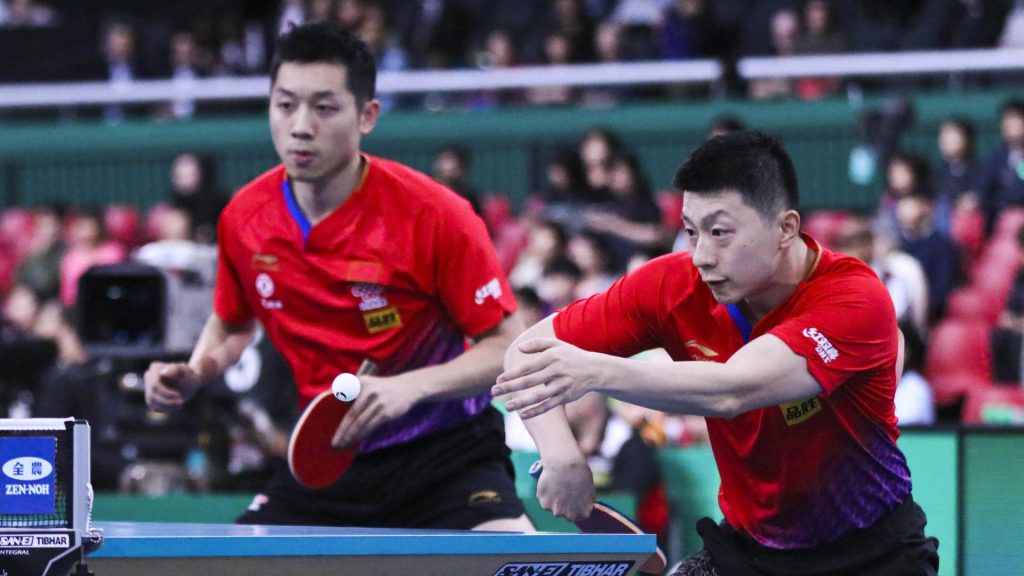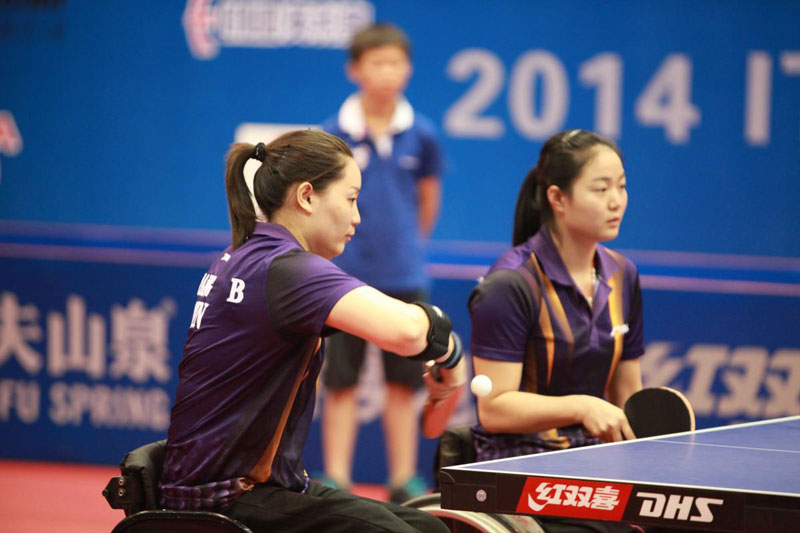Doubles play - what's different to singles?
The service itself is exactly the same as in singles except that, rather than the ball bouncing anywhere on the table, it must bounce only on the right half portion of the table for both the server and the receiver.
The service still alternates every two points between teams, but it also alternates between players on the same team.
The other main difference for table tennis doubles rules is the order in which the players have to play.

The table
Rule 2.01.06 states that…
"For doubles, each court shall be divided into 2 equal half-courts by a white centre line, 3mm wide, running parallel with the side lines; the centre line shall be regarded as part of each right half-court".
This means that in order to play doubles, the table tennis doubles rules state that you must have a table which has a centre line marked on it.
If the ball touches the centre line during service in doubles, the service is “in”.
Order of play
Rule 2.08.02 states…
"In doubles, except as provided in 2.8.3, the server shall first make a service, the receiver shall then make a return, the partner of the server shall then make a return, the partner of the receiver shall then make a return and thereafter each player in turn in that sequence shall make a return."
This means that you must follow the correct sequence for serving and receiving to comply with the table tennis doubles rules.
For example, let’s imagine two teams … A & B and X & Y.
Player A serves to player X who then returns the ball. Player B must then play the next shot and player Y must play the next shot.
The same sequence must then be repeated (A, X, B, Y) until the point is decided.
Players can stand wherever they want, and can play their shots from any position. The only restriction is during the service, when the ball must be behind the server’s end line (the same as in singles play).
Wheelchair users

However, the table tennis doubles rules are slightly different when one or more players are in wheelchairs…
Rule 2.08.03 states:
"In doubles, when at least one player of a pair is in a wheelchair due to a physical disability, the server shall first make a service, the receiver shall then make a return but thereafter either player of the disabled pair may make returns."
and….
Rule 2.10.1.15 states you lose the point:
"if, where an opposing doubles pair includes at least one player in a wheelchair, any part of the wheelchair or a foot of a standing player crosses an imaginary extension of the centre line of the table."
So for players who are in wheelchairs, table tennis doubles rules are slightly different.
After returning serve, either player may play the next shot, and they do not have to play alternately. However, each player must remain in their own half, otherwise they will lose the point.
So what happens if you are…
Playing out of order
Rule 2.10.01.11 states that a team loses a point…
"If a doubles opponent strikes the ball out of the sequence established by the first server and first receiver".
This means what it says … if you hit the ball out of sequence, the table tennis doubles rules say you lose the point.
Order of serving and receiving

Rule 2.13.04 states that…
"In each game of a doubles match, the pair having the right to serve first shall choose which of them will do so and in the first game of a match the receiving pair shall decide which of them will receive first; in subsequent games of the match, the first server having been chosen, the first receiver shall be the player who served to him or her in the preceding game."
This means that you must follow the correct sequence for serving and receiving in doubles throughout the match.
Once it has been decided which team will serve first at the beginning of the match, that team will decide which player in their team will serve first. Their opponents will then decide which player in their team will receive first.
This sequence will then be maintained throughout that game, but in the next game, the sequence will be reversed.
Example...
For example, let’s imagine two teams … A&B and X&Y.
At the start of the match, player A elects to serve first and player X elects to receive first. This means that for that first game, player A will always play his serves to player X.
In the next game, X & Y will decide whether X or Y serves first. When they have decided who will serve first, the receiver will automatically be determined by reversing the sequence of the previous game.
For example, if player A served to player X in the first game and player X elects to serve first in the second game, player A must be the receiver for all of player X’s serves for that game.
Therefore, after the first game, for every subsequent game in the match, each team will decide which player in their team will serve first and then the receiver will be determined automatically by reversing the sequence of the previous game.
Change of service
Rule 2.13.05 states that…
"In doubles, at each change of service the previous receiver shall become the server and the partner of the previous server shall become the receiver".
This means that to abide by the table tennis doubles rules, you must follow the correct sequence throughout each game.
For example, after player A has played his two serves to player X, player X will then play his two serves to player B.
Player B will then play his two serves to Player Y and then player Y will play his two serves to Player A.
Player A will then restart the sequence all over again and the sequence will repeat itself until the end of that game.
Changing ends and order of receiving
Table tennis rules 2.13.06 and 2.13.07 state that…
"The player or pair serving first in a game shall receive first in the next game of the match and in the last possible game of a doubles match the pair due to receive next shall change their order of receiving when first one pair scores 5 points.
The player or pair starting at one end in a game shall start at the other end in the next game of the match and in the last possible game of a match the players or pairs shall change ends when first one player or pair scores 5 points”.
This means that in the last possible game of a match, as soon as the one team has scored 5 points, the teams must change ends and the receiving pair must change their order of receiving.
For example, if A & B score 5 points first, whilst A is serving to X, after changing ends, player A will serve to player Y for the remainder of the game.
Errors in serving or receiving

Rule 2.14.01 states that…
"If a player serves or receives out of turn, play shall be interrupted by the umpire as soon as the error is discovered and shall resume with those players serving and receiving who should be server and receiver respectively at the score that has been reached, according to the sequence established at the beginning of the match and, in doubles, to the order of serving chosen by the pair having the right to serve first in the game during which the error is discovered".
This means that if during the course of a game you discover that you are not playing in the correct sequence, you must stop the game and resume playing in the correct sequence.
The table tennis doubles rules say that all points scored before the discovery of the error shall remain.
Errors in changing ends
Rule 2.14.02 states that…
"If the players have not changed ends when they should have done so, play shall be interrupted by the umpire as soon as the error is discovered and shall resume with the players at the ends at which they should be at the score that has been reached, according to the sequence established at the beginning of the match".
This means that if during the course of a game you discover that you are not playing at the correct end of the table, you must stop the game and change ends.
The table tennis doubles rules say that all points scored before the discovery of the error shall remain.
